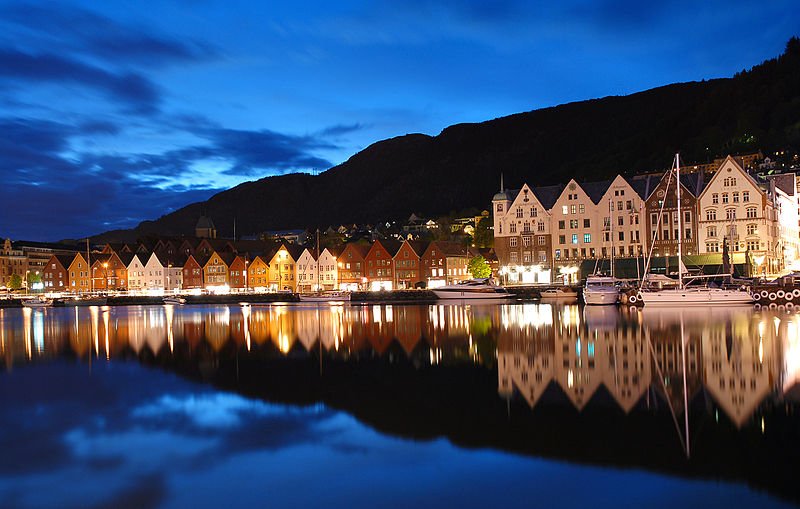 Bergen at night
Bergen at nightSource: https://commons.wikimedia.org/wiki/File:Bergen_by_night.jpg
Author: Pål S. Schaathun

Bergen is the second biggest city in Norway. It is located in Hordaland County on the Atlantic coast in western Norway. The city covers 465 sq km (179.5 sq mi) and has a population of 262,500 (2011 estimate). Bergen is in the Central European Time Zone, which is UTC+1, and in summer the Central European Summer Time, at UTC+2.
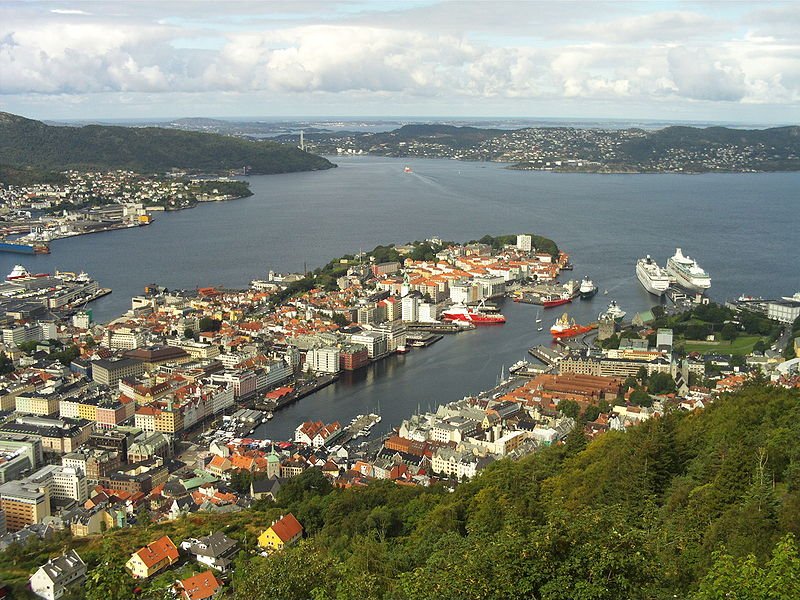 Bergen, Norway
Bergen, NorwaySource: https://commons.wikimedia.org/wiki/File:Panoramica-de-bergen-desde-monte-floyen.JPG
Author: Alfon34

The city of Bergen occupies the Bergen peninsula in mid-western Hordaland. It is sheltered from direct contact with the Atlantic by the islands of Askøy, Holsnøy and Sotra. The city itself is surrounded by a number of mountains, collectively known as de syv fjell or "the seven mountains".
Bergen experiences an oceanic climate. The warmest month is July, with an average high temperature of 17.6°C (63.7°F). The coldest month is January, when the average temperature drops to -0.4°C (31.3°F). September is the wettest month in Bergen, receiving 283 mm (11.14 in) of rainfall. On the whole Bergen receives plenty of rain, amounting to 2,250 mm (89 in) per year.
Bergen comprises nine urban areas. They include Bergen, Indre Arna, Fanahammeren, Ytre Arna, Hylkje, Espeland, Nordvik, Krokeidet and Flesland.
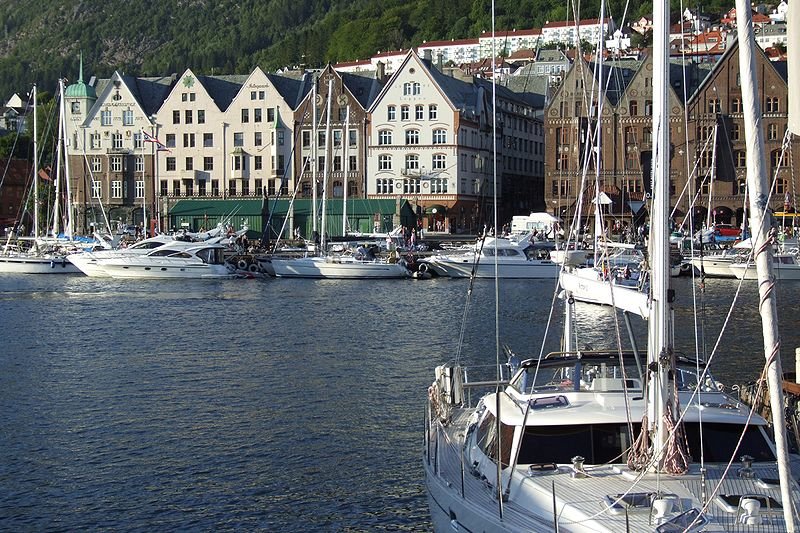 Bergen Harbour
Bergen HarbourSource: https://commons.wikimedia.org/wiki/File:Bergen_-_harbour.JPG
Author: Pudelek

Visiting Bergen
The Bergen Airport Flesland (BGO) receives flights from major cities in Europe. From the airport, there is an airport bus to downtown Bergen. The journey takes about 40 minutes and costs kr. 90 one way, and kr. 150 for a return ticket valid for a month.You can also take the train from Oslo to Bergen. The journey takes seven hours, but you get some picturesque sceneries of the Norwegian countryside.
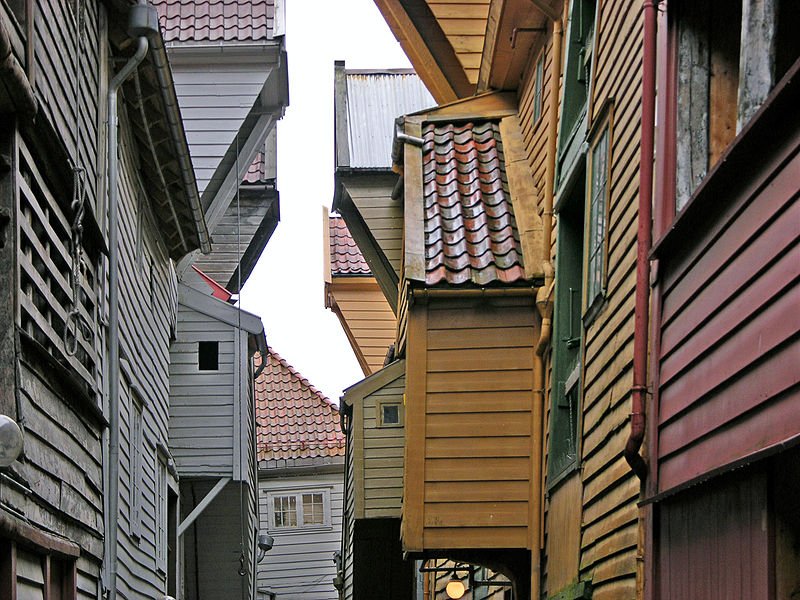 Houses in Bergen Hanseviertel
Houses in Bergen HanseviertelSource: https://commons.wikimedia.org/wiki/File:Bergen_Hanseviertel_II.jpg
Author: Hofi0006

Places of Interest in Bergen
AkvarietThis is Bergen's aquarium. It has the largest collection of sea and freshwater fish in Europe.
Bergen Kunsthall
This is the Bergen Art Association, which stages some 9-10 art exhibits every year.
Bergen Kunstmuseum
The Bergen Art Museum has three main collections housed in two buildings by Lille Lungegårdsvann.
Bergen Museum: De Kulturhistoriske Samlinger
The Cultural History Collection of the Bergen Museum occupies a building designed by Egill Reimers in 1927. It displays items associated with Norwegian culture and folk art, along with some exhibits of foreign cultures.
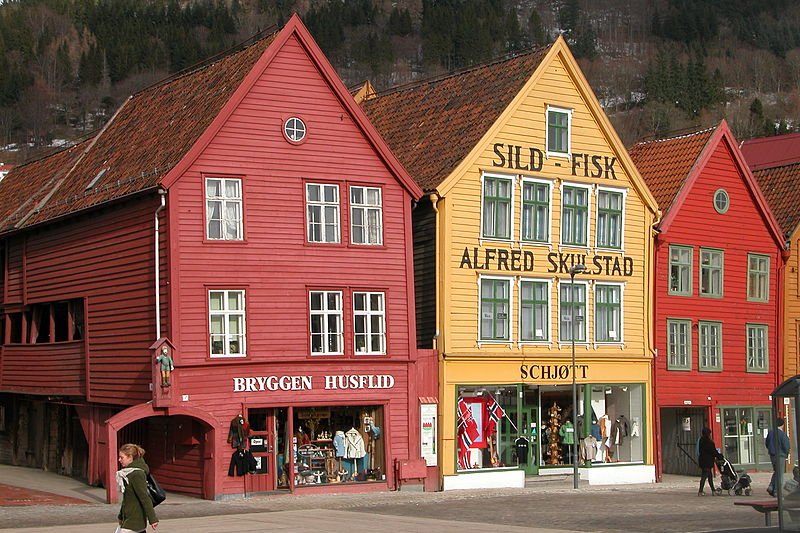 The Bryggen waterfront area of Bergen
The Bryggen waterfront area of BergenSource: https://commons.wikimedia.org/wiki/File:Bergen.Bryggen.1.jpg
Author: Erik Christensen

Bergen Museum: De Naturhistoriske Samlinger
The Natural History Collection of the Bergen Museum features a comprehensive collection of botanic, geological and zoological exhibits along with a botanical garden and a plant house.
Bergens Sjøfartsmuseum
This is Bergen's Maritime Museum. It showcases the history of Norwegian shipping, with an extensive model collection of Viking ships.
Bryggens
This is the Old Quarters of Bergen, a trading center for fish and fish products during the medieval age. Today it is recognised as a World Heritage Site.
Bryggens Museum
Bryggens Museum displays the finds from the archaeological excavations carried out after the massive fire that struck Bergen in 1955. It showcases life in the city during the medieval age.
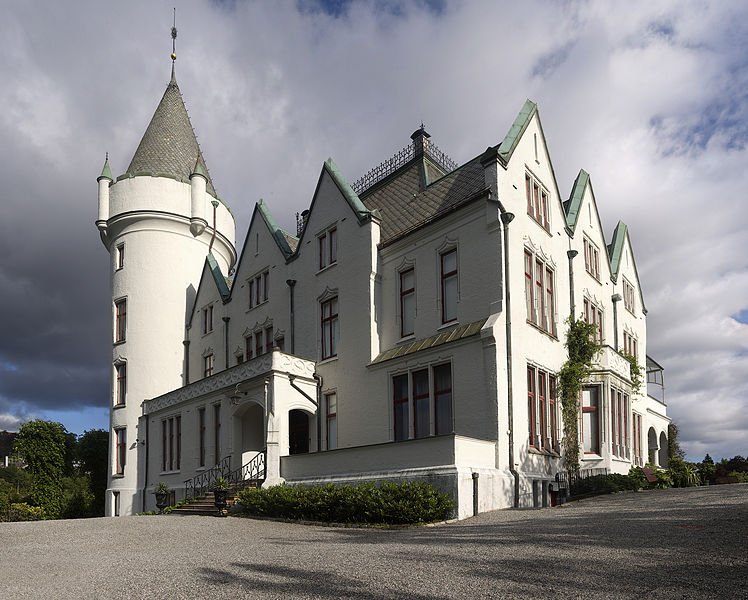 Gamlehaugen, the Norwegian Royal Family mansion in Bergen
Gamlehaugen, the Norwegian Royal Family mansion in BergenSource: https://commons.wikimedia.org/wiki/File:GamlehaugenMainBuilding.jpg
Author: Aqwis

Buekorpsmuseet
A museum of the Bow Corps, a boys' brigade in Bergen.
Den Nationale Scene
This is the Norwegian National Theater, which has its roots in Det Norske Theater in Bergen.
Domkirken
Bergen's Cathedral was originally a parish church, the Olavskirken, established in the 12th century. It was later taken over by Franciscan monks.
Grieghallen
This is a modern concert hall designed by Danish architect Knud Munk and completed in 1978. With a capacity of 1,500, it is the biggest auditorium in Norway.
Hanseatiske Museum
Museum housed in one of the German merchant's houses in Bryggen, showcasing the life of traders of the Hanseatic League.
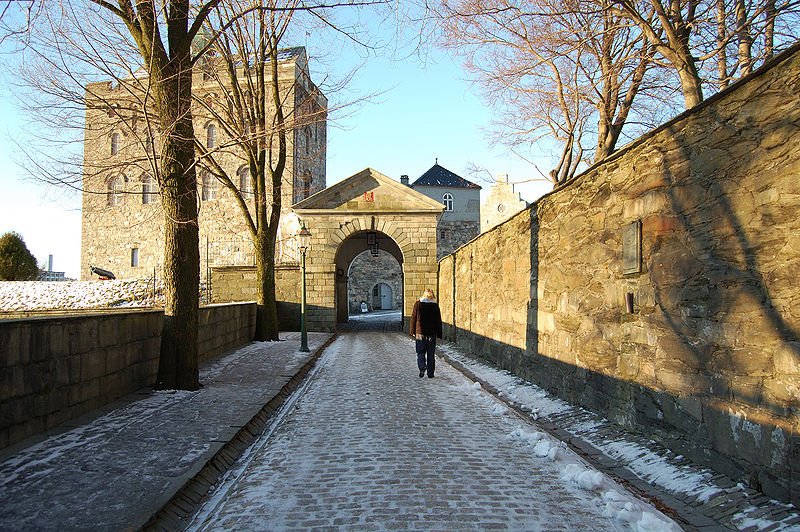 Bergenhus Fortress, Bergen
Bergenhus Fortress, BergenSource: https://commons.wikimedia.org/wiki/File:Bergenhus_Fortress_Bergen_Norway_2009_1.JPG
Author: Sveter

Håkonshallen and Rosenkrantztårnet
Håkonshallen is a ceremonial hall built by King Håkon Håkonsson for the coronation and wedding of his son, Magnus Lagabøter, in 1261. The Rosenkrantztårnet is a tower that was part of the fortifications of Bergen Castle.
Korskirken
The Church of the Cross was erected around AD 1100 in a characteristic cruciform plan.
Kulturhuset USF
This cultural center is housed in the former United Sardines Factories. It provides a venue for contemporary arts ranging from music and film to theater and dance.
Mariakirken
The Church of St Mary is the oldest surviving church in Bergen. It dates from the 11th century, when Bergen received town status from King Olav Kyrre.
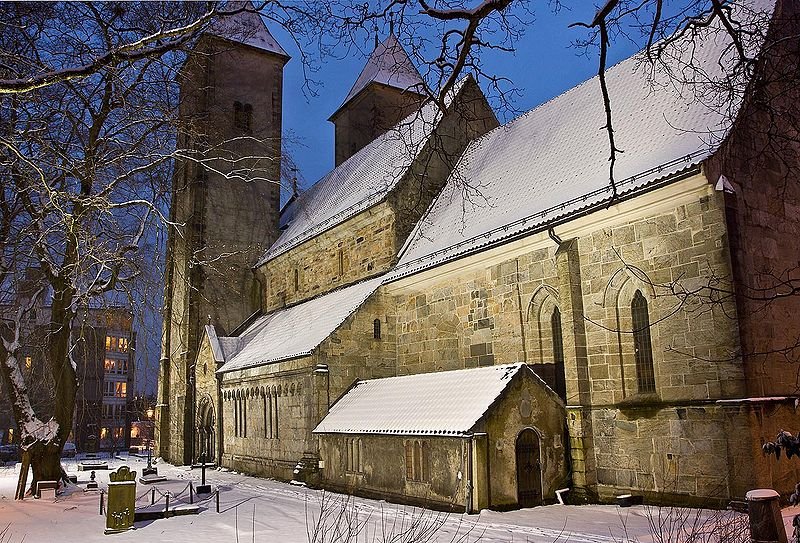 Mariakirken, Bergen
Mariakirken, BergenSource: https://commons.wikimedia.org/wiki/File:Stmarychurch.jpg
Author: Svein-Magne Tunli

Norges Fiskerimuseum
The Norwegian Fishing Museum is located on the Bergen waterfront. It provides an insight into Norway's fishing industry with displays of fishing boats and equipment.
Vestlandske Kunstindustrimuseum
This is the West Norway Museum of Decorative Arts. Also called Permanentum, it showcases a collection of Norwegian and foreign treasures.
Places to visit in the vicinity of Bergen
-
Bergens Tekniske Museum
The Technical Museum of Bergen is housed in the old tram hall in Møhlenpris. It displays technical appliances from vintage cars to washing machines.
Fantoft Stavkirke
The original stave church was built in Fortun in Sogn County in AD 1150, and relocated to Fantoft in 1882. It was destroyed by fire in 1992, and was rebuilt three years later.
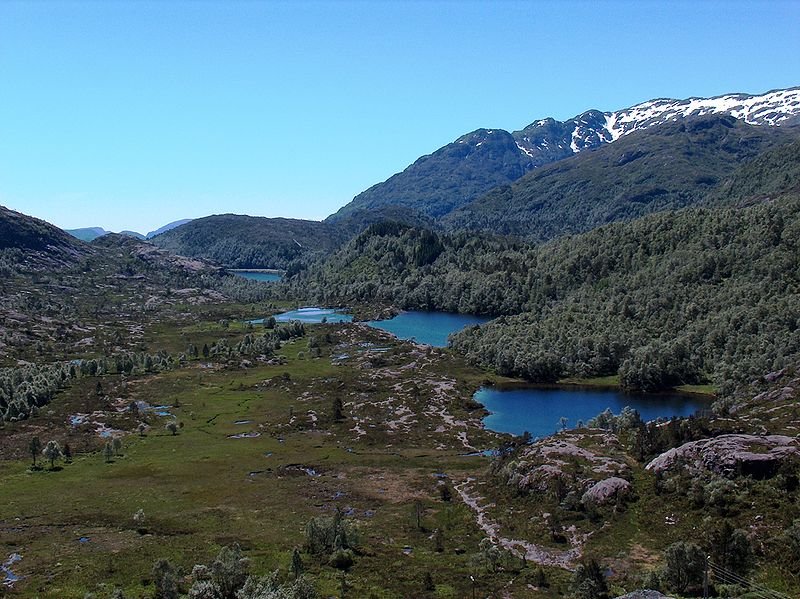 Kraamyrane Naturreservat, Bergen
Kraamyrane Naturreservat, BergenSource: https://commons.wikimedia.org/wiki/File:Kraamyrane_naturreservat.JPG
Author: Svein Harkestad, Bergen

Fløyen
This is one of the seven mountains of Bergen. It is reached by a funicular train.
Gamle Bergen
This is an open-air museum showcasing life in Bergen in the 18th and 19th centuries.
Gamlehaugen
The official residence of the King of Norway in Bergen.
Lysøen
This is the summer island retreat of the famous 19th century Norwegian violin virtuoso Ole Bull.
Troldhaugen
This used to be the home of famous Norwegian composer Edvard Grieg and his wife Nina.
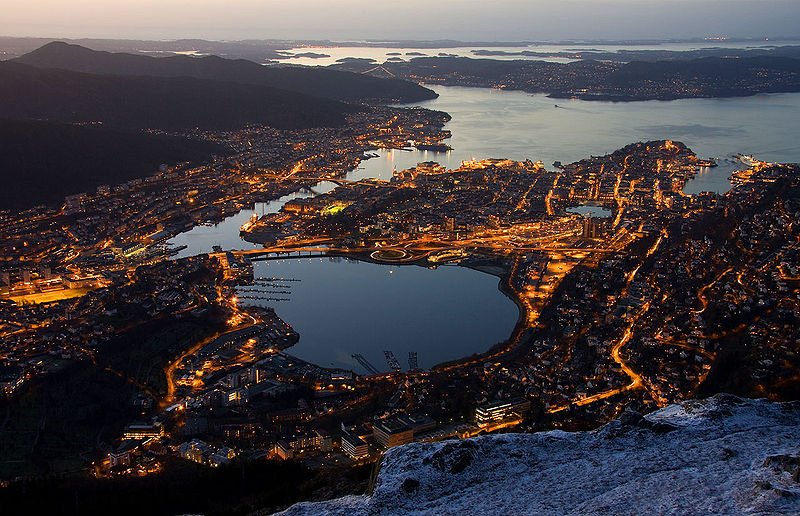 View of Bergen from Mount Ulriken
View of Bergen from Mount UlrikenSource: https://en.wikipedia.org/wiki/File:Ulriken_view.jpg
Author: Svein-Magne Tunli

 Latest updates on Penang Travel Tips
Latest updates on Penang Travel Tips

Copyright © 2003-2025 Timothy Tye. All Rights Reserved.

 Go Back
Go Back